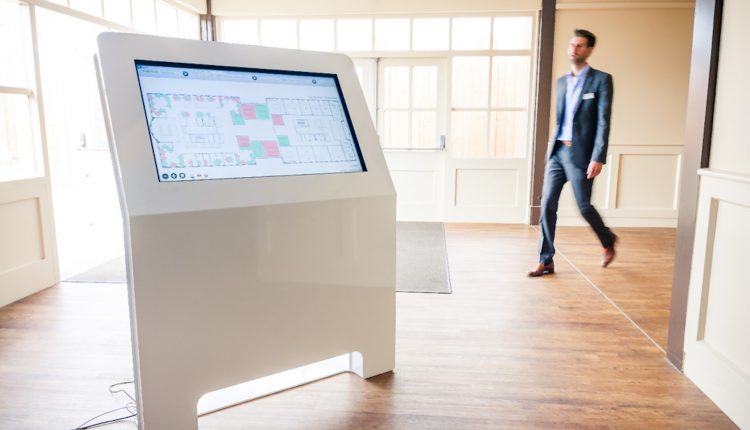 The ambiance of ambience: How artificial intelligence changes occupant experience
The ambiance of ambience: How artificial intelligence changes occupant experience
As artificial intelligence becomes embedded in buildings, spaces, and equipment, a new paradigm for the interaction of people and place is emerging.
By David Karpook
Issue 11 – Spring 2019 pages 50 – 59
Tags: AI • human resources • automation
If a robot received a signal that you had entered the building, it might bring you a fresh cup of coffee just as you reach your desk. If the front door recognized your face, it might unlock itself for you without requiring you to use a fob to gain access. If your desk knew you had left for the day, it might offer itself to a colleague who is looking for a quiet workspace.
Throughout history, the interaction of humans with technology has been pretty much one-sided. We turn our technologies on and off, operate and guide them in their tasks, and use our senses to monitor their functioning and detect anomalies.
But over the past few years, the nature of that relationship has started to change. More and more, our technologies hear us and see us, and take actions without our explicit intervention. Developments in what we call artificial intelligence have been rapid, and they can be unnerving.
Artificial intelligence today is a combination of the practical, the plausible, and the potential. Some of its most interesting manifestations can be classified as “ambient,” meaning that they exist as embedded features in our environment, operating without us having to pay particular attention to them. They rely not on keyboards and screens but on our voices, our movements, and our physical features.
Andrew Ng, the former chief scientist at the Chinese company Baidu, one of the world’s largest artificial intelligence firms, has said that, “AI is the new electricity.”[i] The analogy is compelling. Electricity is so ubiquitous as to be a virtual necessity. When electric power is needed, we assume that we will be able to find a source on the nearest wall; when it is not available, we feel as if civilization has left us behind.
Although it is still in its infancy, there are reasons to suspect that artificial intelligence, particularly in its ambient forms, could develop in ways that eventually make it ubiquitous and necessary in similar ways.
Current experience is telling us that the AI revolution is taking over quietly, and it is becoming an aspect of daily experience without us really being aware of how dramatic the changes are. We talk to our cars, telling them where we want to go, and they respond by giving us step-by-step directions. More and more of us are speaking in conversational syntax with our phones and with devices in our homes to seek information, make appointments, operate appliances, order food, and purchase consumer goods.

Figure 1:
A smart kiosk working in tandem with occupancy sensors can highlight available workspaces for nomadic workers.
This article’s opening scenarios for building behavior are far from outlandish. Consider the following:
- CafeX, at two San Francisco locations, has replaced human baristas with talented, ever-improving robots.[ii] They don’t deliver to your desk yet, but CafeX has targeted corporate office settings in its expansion plans.
- Cloudastructure is one of many companies offering facial recognition-based access control systems. Cloudastructure’s system matches a learning application for face recognition with more traditional access technologies, such as card readers, to provide a multi-layered identification system. Over time, the system learns to recognize a person in different lighting, clothing, hairstyles, and so on.
- Facility management software vendors such as Planon (my employer) have integrated their space management functions with occupancy sensors that allow unused space to be displayed on kiosks and mobile devices so that they can be reserved and used, as well as released for rebooking when an occupant leaves.
Ambient intelligence, as an extension of artificial intelligence, is being enabled by a cluster of emerging technology developments including:
- zero UI, the replacement of a computer-screen-and-keyboard combination with machines that respond to voice, touch, movement, and biometrics such as fingerprint and retina recognition;
- natural language processing, which enables computers to listen to people asking questions or seeking information, understand their words, and reply;
- machine learning, the ability of computerized devices to build skills and improve performance of various tasks without being explicitly programmed to do so;
- mesh networks, which provide continuous connectivity as computerized device users move from space to space or setting to setting. Mesh networks can encompass seamless movement among a multitude of devices, a multitude of applications, a multitude of locations, and a multitude of individual networks; and
- edge computing, which improves responsiveness and turnaround time by moving processing from a “centralized” processing center – most likely in the cloud – to smaller processing centers close to where the information is being created or delivered.
An advance led by the consumer market
One of the greatest cultural transformations of the past decade has been the move to introduce new technologies to consumers first, and then have them brought later into business settings by those consumers who have come to depend on them. Think of smartphones and tablets as the leaders of this revolution.
Over the past few years, voice recognition has come into its own due to consumer adoption of Amazon Echo and Google Home, and increased use of voice recognition capabilities on smart phones and in vehicles. Now we see voice recognition moving into the workplace, with adaptations such as listening devices mounted directly on or in walls. Similarly, facial recognition using 3D cameras is becoming accepted as a security feature on iPhone X devices.
The online journal Bisnow reported in January 2018 on how artificial and ambient intelligence – “smart building” amenities – are changing the residential real estate market:
While building-wide WiFi, electric chargers and rooftop decks remain popular among tenants, smart building technology is becoming the new ‘it’ amenity … In a Schlage and Wakefield Research survey of 1,000 U.S. multifamily renters, 86% of millennials are willing to pay one-fifth more for a smart apartment. Gen Y renters are 61% more likely to rent a unit because of electronic access such as keyless entry, and 55% are willing to pay more in rent for a unit with a smart lock.[iii]

Figure 2:
Evidence is beginning to show that tenants are willing to pay a premium for “smart office” amenities.
The IT analyst group Gartner Inc. predicts that within 5 years, more than 50 percent of facility security will be managed by voice and/or image biometrics.[iv]
Voice and facial recognition are just the beginning. A rapidly developing area of so-called Zero User Interface technology[v] is gesture recognition. Google and Apple were leaders in the consumerization of voice recognition, so it should be no surprise that they are heavily involved in gesture recognition – Google with its Project Soli, and Apple through its acquisition of PrimeSense.
Another company, Leap Motion, has developed a desktop sensor that can read hand and finger motions as input commands. And the Canadian startup Thalmic Labs has developed the Myo armband, a wearable that recognizes gestures and is being used in both the entertainment and medical fields.
Bio-informatics company Emotiv is taking things even farther, developing technology that can take actions based on brainwaves. The company’s initial focus is on providing assistance to people with ALS (Lou Gehrig’s disease), but it is not difficult to imagine a broader commercial use of this technology as it matures.
The emergence of the “smart environment”
What seems more and more to be emerging is the “smart environment,” a long-predicted phenomenon in which a place – a home, an office, a shop, a lab, etc. – can “recognize and respond to the needs of its inhabitants in an almost invisible fashion.”[vi]
Carsten Rӧcker, a professor at the University of Applied Sciences Ostwestfalen-Lippe who has written extensively about ambient intelligence in workplace settings, sees ambient intelligence as a hallmark of the “third wave” of computing, a “post-PC” age characterized by a single person utilizing many computing devices, many of them embedded into everyday objects that do not require traditional input/output devices such as keyboards, mice, and screens.
Innovation is rapid and often surprising in the world of Ambient Intelligence (AmI), but the concept has been around for a generation. It was defined in the late 1990s by the research arm of the electronics giant Philips N.V., which remains a leader in the development of ambient technologies. Philips Research identified three key elements of ambient intelligence: Ubiquity, transparency, and intelligence:
“Ubiquity refers to a situation in which we are surrounded by a multitude of interconnected embedded systems. Transparency indicates that the surrounding systems are invisible and moved into the background of our surroundings. Intelligence refers to the fact that the digital surrounding exhibits specific forms of intelligence, i.e., it should be able to recognize the people that live in it, adapt itself to them, learn from their behavior, and possibly even show emotion.”[vii]
Building on the Philips research, the European Commission’s Information Society and Technology Advisory Group (ISTAG) formally proposed the Ambient Intelligence concept in this way:
Environments that are integrated with sensors and intelligent systems. The environments have the following properties:
- Awareness of the presence of individuals
- Recognition of the individual’s identities
- Awareness of the contexts (e.g. weather, traffic, news)
- Recognition of activities
- Adaptation to changing needs of individuals
“AmI is able to deliver personalized services automatically in anticipation of the needs of the inhabitants and visitors. [viii]
Mark Weiser, a researcher at Xerox PARC, had even earlier — in a 1991 Scientific American article — set out a vision that he called “ubiquitous computing”: “The most profound technologies are those that disappear. They weave themselves into the fabric of everyday life until they are indistinguishable from it.”[ix]
Weiser and the Philips researchers articulated their vision in an age before Google Maps, before the FitBit, before the iPhone changed the way we work, play, and live. Some of us remember that in the 1990s, computers were not “location aware,” the concept of a “wearable” was the stuff of science fiction, and “mobile computing” was a clumsy upstart with an uncertain future.
The desire for ambient operations in buildings found early expression in now-common devices such as thermostats, smoke detectors, and lighting controlled by motion sensors. What distinguishes current development in ambient intelligence – ambient operations supported by strong artificial intelligence — is a move toward extreme personalization.
It Is no longer enough for the interior temperature to be maintained automatically; we want it to adjust to our personal preferences. Lighting turning on and off as we move through a building is worse than passé; we want it to adjust to our color and intensity preferences.
Philips Hue lighting is an example of the latter that is showing up in many homes. It requires interaction with a networked wearable – typically a smartphone – but if all the elements are in place it will, for example, make sure that lights are turned on when the resident comes into range, thus avoiding the need to fumble around in the dark for a light switch or change lighting with a voice command.
Philips has brought this concept into the workplace in the Edge, a new building in Amsterdam where workers can personalize both lighting and temperature at their workstations using a smartphone app. Once set up, the app will control light and temperature for workers wherever they travel in the building, utilizing the network of lights and sensors installed throughout the facility that Philips refers to as a “connected, smart ceiling.”[x]
Personalized Service is a concept that is gaining traction in markets such as transportation, where vehicle manufacturers are developing ever-more sophisticated ways of anticipating the needs and desires of individual vehicle occupants; everything from seat position to interior temperature to music and navigation preferences is being tied to user profiles that live in the cloud.[xi]
Concerns about privacy and human agency
Because it is based on a confluence of powerful technologies that implicitly have the ability to shape our environments and even alter our behavior, ambient intelligence carries risk as well as promise. The Dutch scholar Philip Brey, writing in Ethics and Information Technology, noted that, “One of the fundamental ethical questions regarding Ambient Intelligence is whether it is more likely to enhance human autonomy and freedom, or diminish it.”[xii]
Brey identified three key ways in which ambient intelligence can foster greater human agency:
- by making its environments more responsive to voluntary actions, thus helping people to more easily reach particular goals;
- by supplying people with detailed and personalized information about their surroundings, giving them the ability to interact more successfully with their environment; and
- by allowing the environment to respond to human needs without explicit effort, thus freeing people from “tedious routine tasks.”
As the flip side of this coin, Brey identified three key ways in which ambient intelligence could take away human control:
- by taking actions that do not correspond to the needs or intentions of users;
- by, in effect, telling us how to behave due to making incorrect inferences about a situation; and
- by not simply representing the needs of the user but also incorporating interests of a third party, such as a corporation.
Stories – some well-documented, some apocryphal – have proliferated about the intrusive potential of big data, such as analysis that leads a retailer to suggest purchases that inadvertently reveal personal secrets. Digital assistants have been accused of recommending unnecessary purchases by making unflattering comments to vulnerable consumers, such as children.
Because ambient intelligence rests heavily on the collection and analysis of data, and the ubiquity of collection devices, some of these fears are well-founded. A retail system that knows your purchasing patterns and preferences might use dynamic pricing to entice you into irresponsible purchases. An insurance program that tracks your behind-the-wheel behavior could either lower your rates or raise them based on its judgments of your driving capabilities. A robot that knows how you take your coffee may well know other more personal things about you.
The protection against abusive intrusion into our lives rests in a combination of personal vigilance and organizational responsibility. Machines – even the complex, multi-faceted machines we call buildings – can take over aspects of our life to the extent that we allow them to do so. If the social exchanges that occur in break rooms are important to you, you probably don’t want to allow a robot to bring your coffee to your desk. If personal space is a priority for you, you may need to fight a corporate policy that encourages your desk to be shared by others.
The introduction of ambient technologies in the workspace will inevitably cause tension between users who want the benefits of a personalized environment and organizations that see the benefits of controlling those users. Attempts by corporations, governments, or regulatory agencies to direct the allowable behavior of ambient devices could lead to situations where an environment is considered “disloyal” to its user(s).[xiii]

Figure 3:
Could a “smart” environment become “disloyal” to its occupants?
Opt-out capabilities, manual overrides of automated choices, and other user-specific policies may be needed to prevent, for example, the recording of private conversations in a meeting room without the speakers’ consent. This issue undoubtedly will be a subject of exploration, debate, and, unfortunately, litigation for many years to come as ambient technologies become ever more pervasive in the built environment.
Conclusion
Technology is meant to ease human endeavor. Ambient intelligence suggests a significant leap forward in that it not only makes various tasks easier to accomplish, but it does so without requiring much in the way of explicit commands or controls. Lighting and temperatures that adjust to the desires of occupants; devices embedded in walls and ceilings that track occupancy and that record and transcribe meeting minutes; robots and drones that deliver supplies and necessities to workers when needs are perceived; all of these are science-fiction dreams that are rapidly becoming reality in the 21st-century built environment.
But, as with any technological advance, humans must remain cognizant of what is being gained and what is being lost or threatened. There is no substitute for a pro-active approach to technological transformation to ensure that human needs are truly put first, and that mechanics and electronics are designed and implemented in ways that serve rather than control.
About the Author
 David Karpook is Strategic Business Consultant for Planon Corporation, a leading provider of technology solutions for facility management and real estate. A 25-year industry veteran, he has been a customer, vendor, system implementer, trainer, and strategist, managing workplace technology projects in North America, Europe, the Middle East, and Africa. His additional experience includes seven years as a facility manager and construction project manager at the University of Florida. A graduate architect with degrees from Harvard University and the University of Florida, he has also worked as a journalist for The New York Times and The Orlando Sentinel.
David Karpook is Strategic Business Consultant for Planon Corporation, a leading provider of technology solutions for facility management and real estate. A 25-year industry veteran, he has been a customer, vendor, system implementer, trainer, and strategist, managing workplace technology projects in North America, Europe, the Middle East, and Africa. His additional experience includes seven years as a facility manager and construction project manager at the University of Florida. A graduate architect with degrees from Harvard University and the University of Florida, he has also worked as a journalist for The New York Times and The Orlando Sentinel.
email: [email protected]
LinkedIn: https://www.linkedin.com/in/dave-karpook-re-fm-advisor/
References
[i] Lee, Frank. “Ambient Intelligence – The Ultimate IoT Use Cases,” IoT For All (www.iotforall.com) 6 October 2017 (https://www.gsb.stanford.edu/insights/andrew-ng-why-ai-new-electricity – accessed 13 November 2018)
[ii] Budds, Diana. “Can a $25,000 robot make better coffee than a barista?”, https://www.curbed.com/2018/2/23/17041842/cafe-x-automated-coffee-robot-ammunition-design, 23 February 2018 (accessed 8 October 2018).
[iii] Littman, Julie. “Renters Will Pay More for These Tech-Enabled Amenities,” https://www.bisnow.com/national/news/multifamily/smart-tech-becoming-key-to-attracting-renters-85172, 19 February 2018 (accessed 8 October 2018).
[iv] Yockelson, David and Werner Goertz, “Alexa for Business: B2B/B2E Disruptor Profile,” Gartner Research, 2 March 2018 (https://www.gartner.com/doc/3864763/alexa-business-bbbe-disruptor-profile- accessed 8 October 2018).
[v] Brownley, John. “What is Zero UI? (and Why is it Crucial to the Future of Design?)” Fast Company, 2 July 2015 (https://www.fastcompany.com/3048139/what-is-zero-ui-and-why-is-it-crucial-to-the-future-of-design – accessed 19 November 2018).
[vi] Rӧcker, Carsten. “Toward Smart Office Environments – Benefits and Drawbacks of Using Ambient Intelligence Technologies in Knowledge-Based Enterprises,” Proceedings of the International Conference on Economics, Business, Management and Marketing, October 9-11, 2009.
[vii] Philips Research Online, quoted in “Ambient Intelligence: A narrative in search of users,” by Kristrun Gunnarsdottir and Michael Arribas-Ayllon, Academia (https://www.academia.edu/1080720/Ambient_Intelligence_an_innovation_narrative, accessed 2 August 2018.)
[viii] Lee, ibid.
[ix] Weiser, Mark, “The Computer for the 21st Century,” Scientific American, September 1991.
[x] Philips Cases, http://www.usa.lighting.philips.com/cases/cases/office/edge – accessed 19 November 2018.
[xi] Davenport, Jonathan, and Godfrey Chua,. “Market Insight: IoT-Based Digital Personalization, Part 1 — Improve Customer Retention”, Gartner Inc., 23 April 2018
[xii] Brey, Philip. “Freedom and Privacy in Ambient Intelligence,” Ethics and Information Technology 7(3), pp 157-166, 2006.
[xiii] Bohn, Jurgen and Vlad Coroama, Marc Langeinrich, Friedemann Mattern. and Michael Rohs. “Social, Economic and Ethical Implications of Ambient Intelligence and Ubiquitous Computing,” in W. Weber, J. Rabaey and E. Aarts, editors, Ambient Intelligence, Springer, pp 5-29, 2005.

